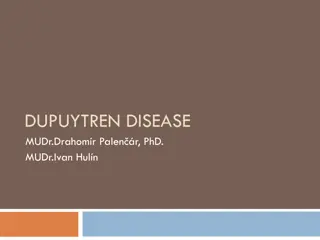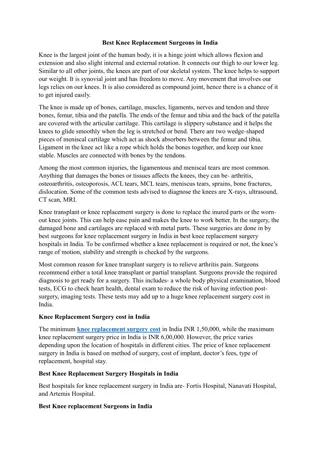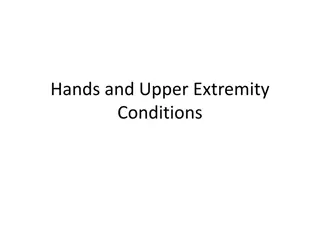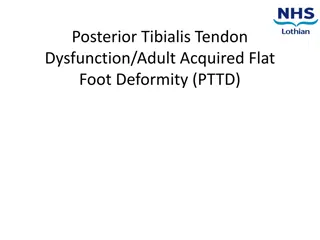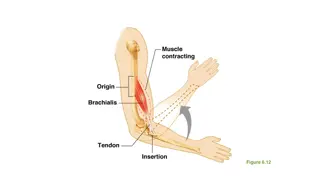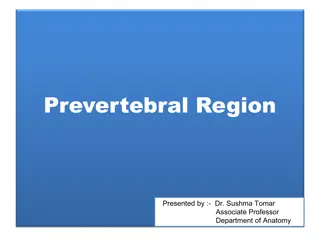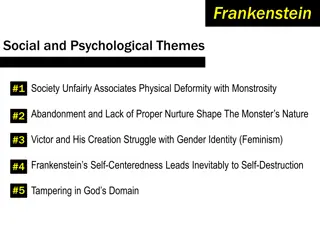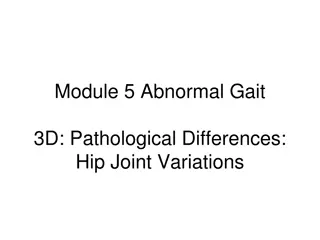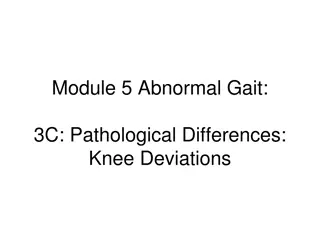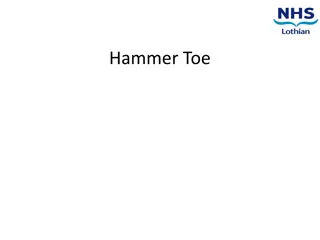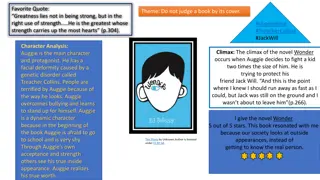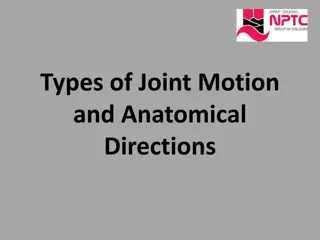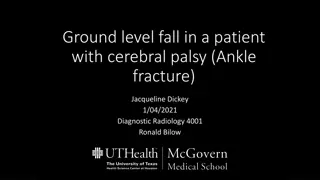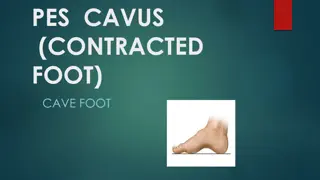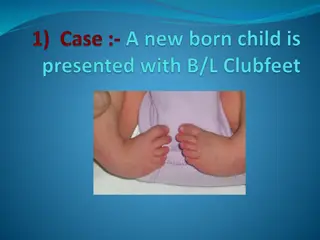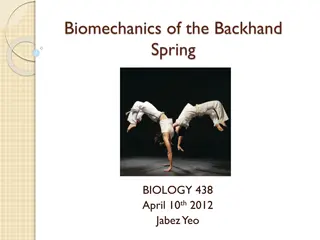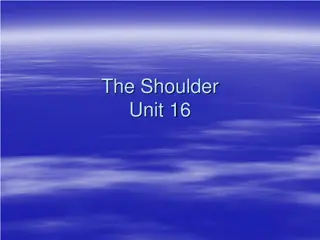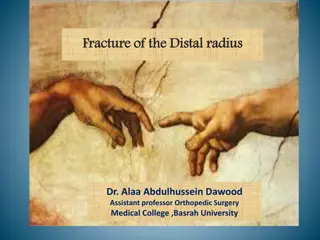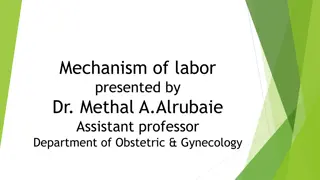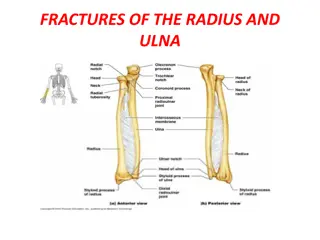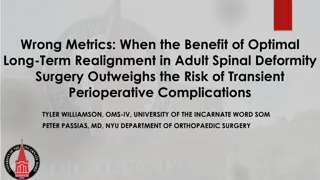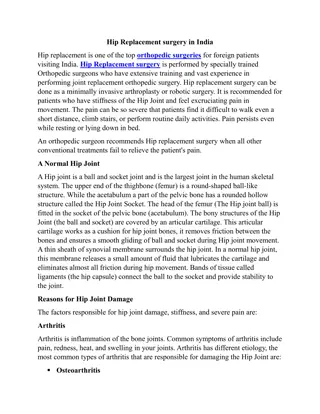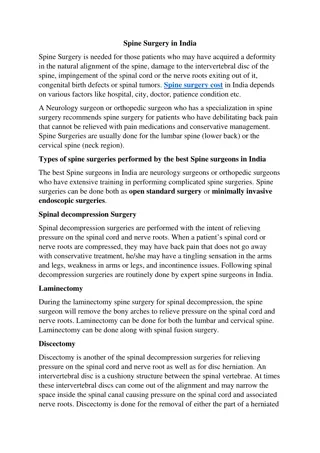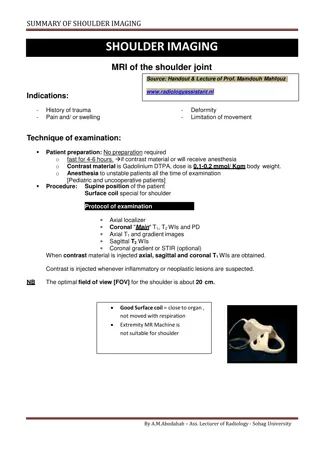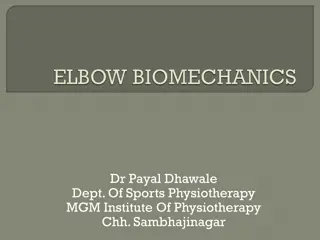Understanding Spondylodiscitis: Diagnosis, Treatment, and Prognosis
Spondylodiscitis is an infectious inflammation affecting the spine's discs and adjacent vertebrae, posing challenges due to potential complications like abscess formation. Early diagnosis and prompt treatment are crucial for a favorable outcome, focusing on infection eradication, pain management, de
0 views • 22 slides
DUPUYTREN DISEASE
Dupuytren's disease is characterized by fibrotic nodules and bands in the palmar aponeurosis, leading to flexion deformities in the fingers. The etiology is unclear, with higher incidence in Europe. Clinical presentation varies, with treatment options including collagenase injections, needle aponeur
4 views • 11 slides
Podiatrist's Role in Managing Foot Involvement in Rheumatic Diseases
Rheumatology encompasses over 200 conditions affecting the musculoskeletal system, with foot involvement being significant in conditions like RA and OA. Podiatrists play a crucial role in diagnosing, treating, and preventing foot problems associated with inflammatory arthritis, such as joint damage,
0 views • 20 slides
Best Knee Replacement Surgeons in India
Knee is the largest joint of the human body, it is a hinge joint which allows flexion and extension and also slight internal and external rotation. It connects our thigh to our lower leg. Similar to all other joints, the knees are part of our skeletal system. The knee helps to support our weight. It
0 views • 2 slides
Innovative Makeup Application Device for Bilateral Upper Limb Amputees
Proposed solution entails a makeup application device designed for bilateral upper limb amputees, enabling independent makeup application. The device incorporates three components: an intermediary device, makeup brush end-effectors, and a change-out station/makeup case. Addressing the need for empow
0 views • 22 slides
Overview of Hands and Upper Extremity Conditions
This informative content covers various hand and upper extremity conditions including nerve innervation, deformities, splints, and syndromes such as carpal tunnel syndrome and cubital tunnel syndrome. It discusses key nerves like the ulnar, median, and radial, their functions, associated deformities
1 views • 40 slides
Understanding Posterior Tibialis Tendon Dysfunction (PTTD) in Adults
Posterior Tibialis Tendon Dysfunction, also known as Adult Acquired Flat Foot Deformity (PTTD), is a condition that affects the tibialis posterior tendon, leading to reduced arch support. Common causes include obesity, trauma, age, and existing health conditions. Symptoms may include ankle pain, swe
0 views • 12 slides
Comprehensive Guide to Body Movements and Special Movements
Explore different types of ordinary body movements such as flexion, extension, abduction, adduction, and circumduction, along with special movements like dorsiflexion, plantar flexion, inversion, eversion, supination, and pronation. Engage with detailed descriptions and visual representations of eac
2 views • 15 slides
Anatomy of the Prevertebral Region in the Neck
The prevertebral region in the neck extends from the 1st cervical vertebra to the upper two thoracic vertebrae. It includes structures like prevertebral and paravertebral muscles, cervical plexus, sympathetic chains, and large vessels. The prevertebral muscles, including rectus capitis anterior and
0 views • 15 slides
Understanding Tuberculosis of Hip and Knee Joint Deformities
Tuberculosis can affect the hip and knee joints, leading to various deformities and complications if left untreated. Common sites of TB in knee joint, neglected cases due to hamstring contracture, path mechanics of deformity development, along with differential diagnoses and treatment options are di
0 views • 8 slides
Themes of Society and Psychology in Frankenstein
Society unfairly associates physical deformity with monstrosity in Mary Shelley's novel, Frankenstein. The abandonment and lack of proper nurture shape the monster's nature, while Victor and his creation struggle with gender identity. Frankenstein's self-centeredness leads to self-destruction, and t
0 views • 14 slides
Pathological Differences in Hip Joint Variations: Abnormal Gait Analysis
Understanding pathological gait variations related to hip joint differences is crucial in gait analysis. Excessive sagittal, coronal, and transverse plane motions impact stance and swing phases, leading to deviations in gait patterns. Excess flexion, limited flexion, past retraction, excess adductio
0 views • 13 slides
Understanding Pathological Knee Variations in Gait Analysis
Explore different knee deviations in gait analysis, such as limited knee flexion, knee hyperextension, extensor thrust, and excess knee flexion. Learn how these deviations disrupt normal gait patterns, impact muscle demands, and affect shock absorption during various phases of the gait cycle.
1 views • 19 slides
Understanding Joint Motion: Osteokinematic and Arthrokinematic Movements
Joint motion involves osteokinematic movements, which are under voluntary control and include flexion, extension, and more. End-feel sensations like bony, capsular, and springy block indicate different joint conditions. Arthrokinematic motion refers to how joint surfaces move during osteokinematic m
0 views • 17 slides
Understanding Hammer Toe: Causes, Symptoms, Diagnosis, and Management
Hammer toe is a flexion deformity of a toe that can cause discomfort and pain, often worsened by ill-fitting footwear or weight-bearing activity. The condition can be caused by factors like bunions, trauma, or toe joint instability. Symptoms may include pain at the joint of the affected toe and seco
0 views • 12 slides
Wonder Novel Review and Analysis
A comprehensive review and character analysis of the novel "Wonder" by R.J. Palacio. Explore the central themes of kindness, inner strength, and overcoming adversity through the protagonist, Auggie, who faces challenges due to a facial deformity. Witness the climax where Auggie stands up against bul
0 views • 4 slides
Essential Joint Motions and Anatomical Directions Explained
Explore various types of joint motions such as abduction, flexion, rotation, and more, along with anatomical directions like anterior, posterior, superior, and inferior. Understand the body's movements and positions with detailed illustrations in the anatomical context.
0 views • 10 slides
Ankle Fracture in a Patient with Cerebral Palsy: Diagnostic Radiology Case Study
A 57-year-old male with a history of cerebral palsy presented with ankle pain following a ground level fall. Examination revealed a Danis-Weber type B3 fracture subluxation and a displaced age-indeterminant fracture of the talar neck with midfoot collapse. Key imaging findings included soft tissue s
0 views • 15 slides
Understanding Pes Cavus: Causes, Symptoms, and Treatment Options
Pes Cavus, also known as contracted foot or cave foot, is a foot deformity characterized by an elevated medial longitudinal arch, causing the forefoot to be lower than the hindfoot. This condition can lead to pain, clawed toes, and other complications. Treatment options include orthotics, exercises
0 views • 7 slides
Club Foot (Congenital Talipes Equinovarus): A Comprehensive Overview
Club foot, also known as Congenital Talipes Equinovarus, is a condition characterized by a tri-planar deformity of the foot. This article covers the aetiology, clinical features, diagnosis, treatment options, and patient management strategies for club foot. It discusses the gene variations, environm
0 views • 26 slides
Biomechanics of the Backhand Spring Movement
Understanding the biomechanics of the backhand spring, an acrobatic maneuver involving full body rotation, can be crucial for performers in activities such as cheerleading and gymnastics. The movement requires precise coordination of shoulder adduction, hip flexion, and hyperextension of the spine a
0 views • 14 slides
Understanding Upper Extremity Injuries and Shoulder Physiology
Upper extremities are prone to various injuries in sports, including sprains, strains, dislocations, fractures, and repetitive motion injuries like arthritis and tendonitis. The shoulder complex involves bones, muscles, tendons, ligaments, and articulations. Joints like the sternoclavicular, acromio
0 views • 63 slides
Distal Radius Fracture: Diagnosis, Management, and Complications
Distal radius fractures, particularly Colles fractures, are common injuries, often affecting elderly women due to osteoporosis. These fractures typically result from a fall onto an outstretched hand, causing dorsal and sometimes radial displacement of the distal radius fragment. Clinical features in
0 views • 32 slides
Understanding the Mechanism of Labor: Fetal Movements and Delivery Process
The mechanism of labor involves a series of positional changes the fetus undergoes during birth. It includes engagement, descent, flexion, and internal rotation to facilitate the delivery process. Each movement plays a crucial role in ensuring the successful delivery of the baby's head through the b
0 views • 9 slides
Themes of Society and Psychology in Frankenstein
Society unfairly associates physical deformity with monstrosity in Frankenstein, shaping the monster's nature through abandonment and lack of nurture. The struggles of Victor and his creation with gender identity and self-centeredness lead to self-destruction, illustrating themes of tampering in God
0 views • 14 slides
Understanding Genu Varum (Bow Leg Deformity) and Its Management
Genu varum, or bow leg deformity, is characterized by lateral angulation of the tibia in relation to the knee, leading to a widened stance. Causes include early weight bearing, conditions like Blount's disease and rickets, and osteoarthritis in adults. Treatment options range from special shoes and
0 views • 6 slides
Fractures of the Radius and Ulna: Mechanism, Clinical Features, and Treatment
Fractures of the radius and ulna commonly occur due to various forces like twisting, angulating, or direct blow. Symptoms include pain, swelling, and deformity, with potential circulatory or neural deficits. Diagnosis involves X-rays, and treatment varies for children and adults, from closed reducti
0 views • 31 slides
Benefit of Long-Term Realignment in Adult Spinal Deformity Surgery
Recent literature highlights the benefits of surgical intervention for adult spinal deformity, despite the potential for transient perioperative complications. This study aims to explore the long-term outcomes of optimal realignment in ASD surgery, emphasizing the significance of achieving improved
0 views • 14 slides
Hip Replacement surgery in India
Spine Surgery is needed for those patients who may have acquired a deformity in the natural alignment of the spine, damage to the intervertebral disc of the spine, impingement of the spinal cord or the nerve roots exiting out of it, congenital birth
1 views • 4 slides
Spine Surgery in India
Spine Surgery is needed for those patients who may have acquired a deformity in the natural alignment of the spine, damage to the intervertebral disc of the spine, impingement of the spinal cord or the nerve roots exiting out of it, congenital birth
0 views • 3 slides
Comprehensive Guide to Shoulder MRI Imaging and Interpretation
Shoulder MRI imaging is valuable for assessing trauma, pain, swelling, deformity, and movement limitations. This detailed guide covers patient preparation, examination techniques, protocol, and interpretation of shoulder scans including assessment of tendons, ligaments, bursae, and bones.
0 views • 12 slides
Muscles of the Anterior and Medial Thigh Anatomy Overview
Explore the anatomy of the muscles in the anterior and medial compartments of the thigh, covering origins, insertions, nerve supplies, and actions. Learn about the divisions, compartments, and common muscles responsible for knee extension and hip flexion. Discover the structures of the femoral trian
0 views • 18 slides
Understanding the Elbow Joint Complex and Its Functionality
The elbow joint complex is crucial for both mobility and stability of the hand, serving a uniaxial diarthrodial joint of hinge type with one degree of freedom of motion. Composed of the humeroulnar, humeroradial, proximal radioulnar, and distal radioulnar joints, it articulates surfaces such as the
0 views • 47 slides

